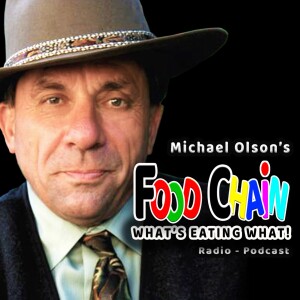
814
Downloads
61
Episodes
It’s a fact! 100% of men, women and children eat food, and 97.5% of must buy their food from others who bring it from an average of 2,000 miles away. And so the hungry ask: ”What’s in this tomato? Who planted that broccoli? Is it safe to eat genetically engineered corn? Why are they irradiating meat? Are we running short of water? Why is China growing our apples? What will happen to us if we can no longer farm? How safe is our food chain?” The Food Chain is an audience-interactive syndicated newstalk radio program and podcast broadcasting weekly on radio stations and streaming on demand on the internet. The Food Chain, which has been named the Ag/News Show of the Year by California’s legislature, is hosted by Michael Olson, author of the Ben Franklin Book of the Year award-winning MetroFarm, a 576-page guide to metropolitan agriculture. The Food Chain is available live via GCN Starguide GE 8 and delayed via MP3/FTP. For clearance and/or technical information, please call Michael Olson at 831-566-4209 or email michaelo@metrofarm.com
Episodes

Sunday Aug 04, 2024
Ep. 1357: Yellowstone's Crows of Winter
Sunday Aug 04, 2024
Sunday Aug 04, 2024
John Marzluff, Emeritus Professor of Forest Sciences, University of Washington, Author of In the Company of Crows and Ravens
(Animal Nutrition and Environment)
Yellowstone Park in winter is a cruel place for the wildlife that can no longer endure its cold, snow and hunger. And yet what is cruel for some can be a blessing for the corvids of Yellowstone’s winter And so we ask:
Can anyone love the black birds of Yellowstone’s white winter?
There was a stretch of years when wife Marlene and I would sneak off to Cooke City, Montana, for some cross country skiing. In winter, Cooke is a snowbound little town at the very end of the only open road through Yellowstone Park.
Though Cooke City is well known among snowmobilers for its access to the stunningly beautiful high country, snowmobilers and cross-country skiers are not of a kind. Our aim, as skiers, was Yellowstone’s Lamar River Valley, which is, thankfully, off limits to the noisy, smelly snowmobiles.
The Lamar Valley is the wintering grounds for many of Yellowstone’s animal populations. And our cross country skis allowed us to fly over the surface of snow packs the animals had to plow their way through. We were not the only ones flying about the Lamar with such abandon. So, too, were the corvids – Yellowstone’s black birds on white snow.
Yellowstone’s winter is a cruel time for the animals that can no longer survive the cold, snow and lack of food. But from what we saw, while flying over the snowpacked landscape, was that winter was treating crows and ravens with lots of opportunity to feast, and their feasting often sounded as raucous as an out-of-bounds wedding celebration.
From watching their feasting, and from watching them watch us as we flew across the landscape, we came to see corvids as being winners of Yellowstone’s season of losing. And we wondered:
Can anyone love the black birds of Yellowstone’s white winter?
